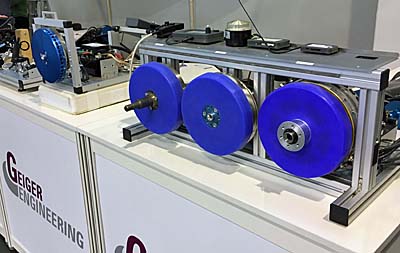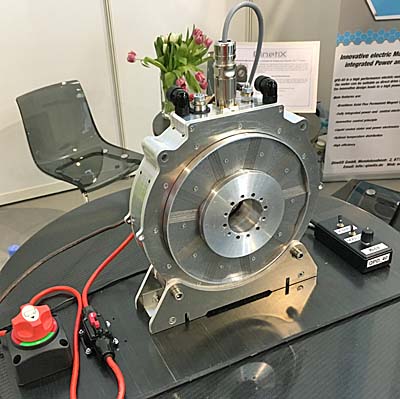Electric aircraft may still have minuscule market share but innovations could change that in the near future. As Aero correspondent, Roy Beisswenger wrote, “This is a rapidly changing technology with both motors and applications showing up all over Aero Friedrichshafen.” This year Aero management concentrated them in one of the big halls where small startups to the heavyweights were located. Thanks to Roy for several reports from Aero, of which this is one. —DJ

Geiger Engineering electric motors, components, and even props are offered.
Many of the exhibited motors are for very light applications such as light-weight shift control trikes or gliders but motors are becoming more powerful. With an increase in power, new technical problems need to become overcome. For example, the larger the power capability of the motor, the more cooling is required for the motor. Smaller motors are mostly air-cooled, but some of the medium and larger motors require liquid cooling. This doesn’t mean that the motors have radiators, but liquid is built into the motor to help wick heat away from hot spots that are created when electricity is converted to mechanical power.
Essentially we find three components to electrical power systems: (1) the motor itself, (2) batteries, and (3) a controller. The controller makes sure that the proper amount of electricity is delivered to the motor. Most of the electric motor developers are also developing controllers for their motors since the two work with each other so closely.
Some companies, such as the German company Geiger, are offering complete systems from batteries to motor, and sometimes even propellers.

A smaller German company, Qinetix, has integrated the controller with the motor, easing the task of airframe makers.
Another German company, Qinetix, is not only developing a motor and controller but is placing the controller inside the case along with the engine. It means that aircraft builders only have to mount the motor and run power leads to it. The QPD-40 is an integrated system that is actually designed to be an electric replacement for the now-discontinued but once very popular Rotax 503 two-stroke engine. The designer explained that he had a trike with that engine and wanted the replacement for himself. He figured others would want it, too. The motor is still being tested and should be available later this year.
- Specifications:
- Power – 40KW (53 hp)
- Weight – 12 Kg (26 lbs)
- RPM – 1800
- Torque – 212 Nm
- Voltage – 60 Volt
- Current – 680 Amp
- Power Density – 3.2 KW/kg
Of course it takes a while for prototype motors to make their way onto production aircraft. A walk around the displays reveals that the motors from Geiger Engineering are finding a good reception from airplane manufacturers or experimenters. Geiger is currently producing five motors ranging from 12KW to 50KW (16 to 68 horsepower) making them popular for a variety of airframers. Even more appealing is that Geiger is one of the companies offering complete systems from battery packs designed for aviation all the way through propellers.
To Roy’s report I add my own observation: As government agencies around the globe ponder how they wish to regulate electric propulsion — often prohibited by existing regulation, as in the USA — these devices are changing fast enough to make it challenging for authorities. From automobiles to airplanes, rule writers are lagging the development but they may catch up before these motors hit the market in volume. Batteries are improving at a slower pace but may be one major breakthrough away from going mainstream. After that, electric cars and airplanes may give combustion engines a real run for their money. —DJ


Hi! I am looking for 50 kw electric engine for a UAV application. Do you provide electric engine with controller for the same?
I am not sure who you want to read your question but I advise using the Search on ByDanJohnson.com to learn more. Articles have lots of links to aid your search. Tail winds!
I would like to buy a motor, controller and batteries for ultralight flight.
Hi Don: As noted in another comment, please contact Electric Aircraft for more information.
I’m looking for an electric power system for an ultralight or light sport aircraft; i.e. 50 to 80 horsepower. Do you provide electric power kits including motor, controller, battery, instrument, etc.?
Also, does FAA allow electric motors on amateur-built Light-Sport and / or ultralight planes ?
Hi Dee: Finding the right electric propulsion system is still an exercise in discovery. You will have to communicate with companies we’ve reported and they will need more info than a supplier of gasoline engines. This is an exciting area of development but please proceed with care!
FAA does allow electric on Experimental Amateur Built aircraft — as you can do anything you want on an EAB design. Light-Sport aircraft are not EABs and do require FAA acceptance. FAA regulations for LSA presently disallow electric but that will change when the revised regulation comes out in two or three years. Ultralight aircraft can use any powerplant they wish so long as the vehicle doesn’t exceed 254 pounds of empty weight …though that, too, may change in the future (not because they will change the Part 103 regulations — no one wants them to alter it — but because FAA is aware that batteries are not “fuel” per an official FAA decision (from FAA legal).